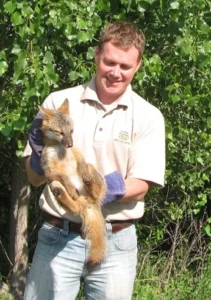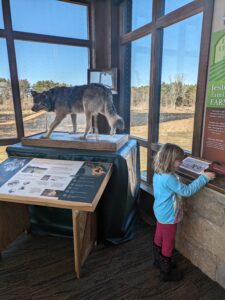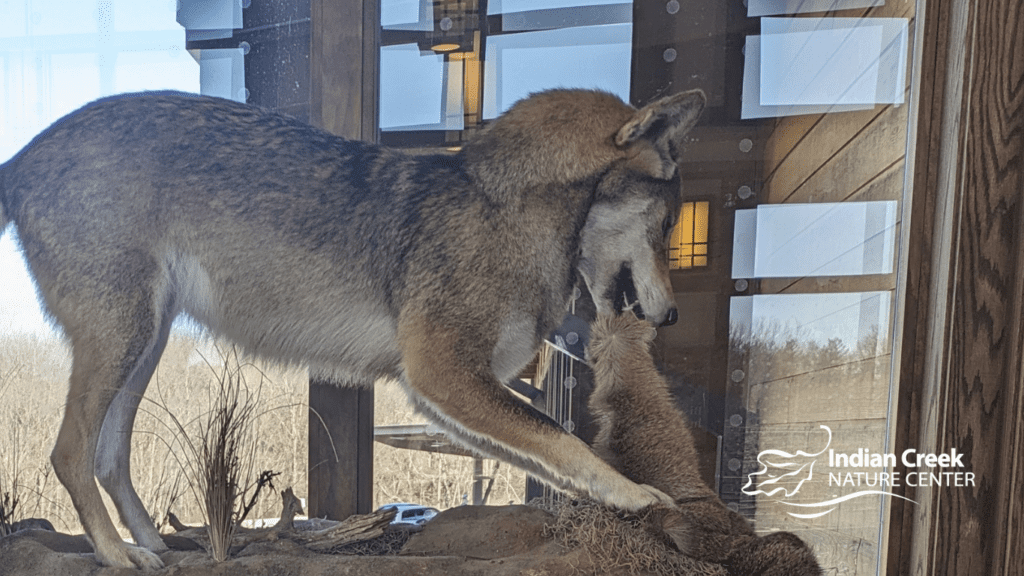Indian Creek Nature Center is pleased to showcase the International Wolf Center’s Wolves and Wild Lands Traveling Exhibit from November 3 – 27.
The exhibit is composed of six preserved taxidermy specimens; Arctic wolf, Mexican wolf, Coyote, Red wolf, Rocky Mountain wolf and Great Plains wolf. Graphics, recent research and population statistics will also be featured for each.
Along with the Wolves and Wild Lands Traveling Exhibit, additional education opportunities will be offered.
Wolf Event for Lifelong Learners

DNR State Expert Furbearer and Wetland Biologist, Vince Evelsizer, will be at Indian Creek Nature Center on Sunday, November 3rd to give an Overview of Wolves in North America.
Vince will share how wolves have been the subject of folklore, children’s books and scientific research that has taught us more about these wonderful creatures. Join us as we discuss the past, present and future of wolves in North America and how it relates to Iowa. This presentation will be geared towards adults.
Register for Overview of North American WolvesFamily Fun with Night Creatures
A family-friendly wolf program will be offered on Saturday, November 16th.
At Family Fun with Night Creatures, participants can enjoy animal activities, a wolf pup zoom presentation where you see what it’s like to grow up as a wolf and follow the ambassador wolves through their first year of life. Learn all about the stages of pup development and what it takes to raise wolves at the International Wolf Center!
Following the live zoom pup presentation there will be more night animal activities, a family picnic (please bring your own) and black light flashlights will be provided for a night walk allowing us to follow real animal tracks that glow in the dark. The entire family will enjoy this unique chance to meet a wolf pup and track creatures of the night!
Register for Family Fun with Night CreaturesBrief History of Wolves in Iowa
The following information was taken directly from the book Iowa’s Changing Wildlife by James and Stephen Dinsmore.
Prior to European settlement, gray wolves were found across most of North America from Alaska and Canada south through the US into Mexico and also across much of Europe and Asia. Throughout their range, wolves were disliked for their depredations on domestic animals and the fear that they were a threat to human lives. As a result, they were aggressively hunted, trapped, poisoned, or otherwise killed in attempts to extirpate them. Wolf populations declined greatly, and their range contracted as they retreated from areas where humans were numerous. In North America, wolves disappeared from much of their original range and by the early 1900s persisted mainly in remote areas of the northern United States, Canada, and Alaska.
Gray wolves were native to Iowa with numerous reports of their presence in the state. These wolves probably came from two sources. Most probably came from the wolf populations around the Great Lakes. Those animals, a subspecies commonly called timber wolves, almost certainly ranged south into Iowa where early settlers often encountered them. Others probably came from the Great Plains where wolves were fairly common and often associated with bison herds.
One seen in Butler County in the winter of 1884 – 1885 is considered the last legitimate report of a wolf in Iowa prior to recent years.
Although wolves had disappeared from Iowa by 1900, a population persisted in northern Minnesota. Those animals have been the subject of much controversy between people who want them protected and those who want them exterminated. All wolves in the Lower 48 states were given protection under the Endangered Species Act in 1973. During the late 1900s, wolf populations in Minnesota increased, and they expanded their range south in Minnesota and adjacent areas of Wisconsin and Michigan.
Return of the Wolves

Convincing evidence of wolves in Iowa came in February of 2014 when a seventy-pound female was shot in Buchanan County, Iowa’s first confirmed record of a wild gray wolf in more than 125 years. DNA from that animal confirmed that it was derived from wolves that occupied Minnesota and adjacent states.
In the last decade, Iowa has had approximately 12 confirmed wolf sightings and close to 30 additional sightings with the latest confirmed wolf found in Scott County in February of 2024.
According to a 2018 DNR news release, while wolves are more capable of hunting larger prey, their numbers in Iowa are so low that their presence is not expected to heavily reduce deer populations in the state. At this time, we estimate there to be five or fewer wolves in the entire state of Iowa at any given time. Time will tell if this number trends upwards or not. Still, the next time you see an Iowa canine you might want to look a little closer – you could be witnessing the return of a majestic Iowa predator population.

